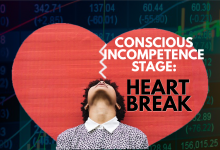We all feel down at some point in our trading career. Just like a heartbreak, a devastating big loss or series of losses will make you feel miserable and more often, you are looking to quit. This is the time you are already conscious that you are still incompetent in the craft of trading. You know, deep inside, that you do not know anything yet.
If you have come to a point that you are aware and conscious that the craft of trading is not as easy as you think, then congratulations, you levelled up from the Infancy Stage. This is where most traders realize that the promised quick money, passive income, and life by the beach is not aligned with what they have been expecting.
Conscious Incompetence Stage is where most traders quit, get stuck, or worst is that they revert to the Unconscious Incompetence stage and have that never ending cycle of non-profitability.
Common Characteristics of Traders in the Conscious Incompetence Stage:
Finding the Holy Grail
With a recent heartbreak with Ms. Market, traders embark in a quest to find the perfect strategy, THE HOLY GRAIL. They begin increasing their knowledge by going to trading groups, applying for seminars, reading books, watching YouTube videos and finding mentors/gurus that might help them in their search of that holy grail. They are the most active in finding ways to perfect their trading and investing style.
Risk Averse and Fearful
Since that traumatic losses, trader become Risk Averse. Unlike in the infancy stage when they are just buying in FOMO (Fear of Missing Out), this time they have this biased mindset that the price might go down if they buy. Traders will be unable to execute their setup quickly resulting to missed opportunities and more heartbreak for them.
Heartbroken
From being one of the happiest and loudest in social media, traders become quiet at this stage. Some traders might come to the point of depression. If you experience depression, I highly suggest you seek professional help to get you through this phase. Talk to your loved ones or to fellow traders so that you can release the burden of what you are feeling during this phase.
How will the Conscious Incompetence Stage end?
This is the stage where you will truly know yourself and find out if you still want to continue this path. Just like in any romantic movies, the leading couple always have their ME time or soul searching to find what is wrong with them that might have caused the break-up of their relationship. If you are AWARE what you need to improve, ACKNOWLEDGE it, put an ACTION to it, then this might be the start of the ending of this Conscious Incompetence Stage.
How to Overcome the Unconscious Incompetence Stage?
Quit searching for the holy grail. It is important that you increase your knowledge in trading but to fasten your learning curve, you must know the deeper purpose on why you pursue the craft of trading. It will always fall in your commitment to re-assess.
Re-assess yourself. Maybe you are trading against your personality or availability. Maybe there are habits that you need to change for you to be more productive. To accelerate your learning curve, first, work on the things where you can focus.
Focus. Know what you really want to achieve and grind for it. Focus on mastering one strategy at a time to start earning from the market consistently earlier than others. Know why you are using it and how it will help you in attaining your goal, in achieving mastery.
Mastery of the basics and self-mastery. These two things must come hand in hand. Grasping both will give you a good understanding on how your system works with confluence to your goals as a trader or investor.
Only traders that can find that Aha! Moment in their trading career will be able escape this stage. To find it, you must search this within yourself. Remember this quote from a famous movie; “Everyone fails at who they are supposed to be, Thor. The measure of a person, of a hero…is how well they succeed at being who they are.” (Frigga, Avengers: Endgame).
Contributor:
Full Name: Jan-Angel Echano
Investagrams username: @Soral
Channels:
www.investagrams.com/Profile/soral
www.facebook.com/soraltrading
www.twitter.com/SoralTrading
www.instagram.com/jan_soral/
www.anchor.fm/soral
www.youtube.com/c/SoralTrading
About the Contributor:
A passionate trader who aims to share the reality, the HOWs and the WHYs in trading. My goal is to help traders and investors like me to continuously improve and refine our skills to the path of mastery.
